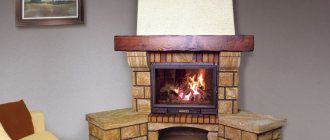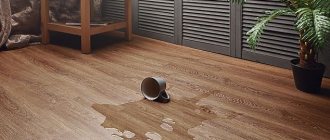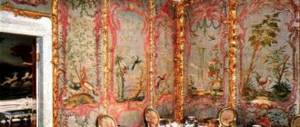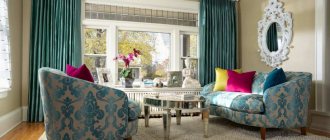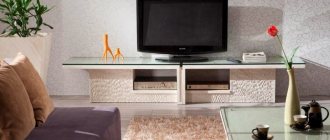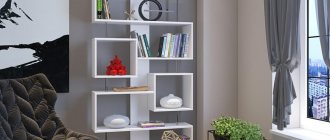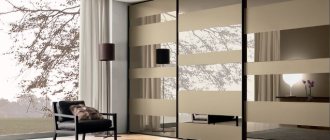Related Articles
Wide range of frequency converters: ksimex-electro.com.ua
03.02.2018
How to properly hang vinyl wallpaper
31.01.2018
How to renovate a 3-room apartment
24.01.2018
A modern living room should be simple, and at the same time functional, spacious, and stylish. The times when the hall was overloaded with oversized walls and various non-lifting cabinets have sunk into the past. Nowadays it is fashionable to furnish living rooms with modular walls that do not clutter up the space, but at the same time allow you to conveniently and compactly place all the necessary things.
Modular wall in modern living room design
Interior of a living room with a modular wall made of solid wood
Living room design with a modular wall
Advantages and disadvantages
Today, modular walls are popular, and this is not surprising.
- If desired, the wall can be redone at your discretion, individual modules can be rearranged or removed. Any combination creates a complete piece of furniture for the living room.
- Individual blocks can be modified, for example, by reworking the facade, which completely changes the design of the wall. Thanks to this feature, you can add variety to the decoration of the living room.
- An ideal option for small living rooms or rooms of a non-standard configuration, due to the fact that you can purchase only those modules that are necessary and will clearly fit into the space allocated for them.
- The presence of corner sets allows you to make the most of the space in the hall. In addition, with the help of corner sections you can create a U-shaped arrangement of furniture, thus hiding the corners.
- A huge variety of shapes, sizes, colors, textures, materials and functional design features.
- Possibility of installation without inviting a specialist.
The only disadvantage we can highlight is that if there is a need to purchase additional modules, they cannot always be found. And another drawback is that it is difficult to match the set to the interior in a classic style.
Modular furniture system in the interior of the living room
Modular wall in the living room interior
Production materials
When creating modular elements the following are most often used:
- Solid wood.
- Chipboard and MDF.
- Metal alloys.
- Glass.
In addition to the appearance of the furniture, you need to pay attention to the material of its production. The service life and ease of maintenance depend on it.
Decorate a very large living room using a modular system
Wood is an environmentally friendly base, harmless to use. However, the price category is not available to everyone.
Wood panels are made from sawdust and shavings. The only difference is that for good bonding, MDF contains resin.
Wood is an environmentally friendly base, harmless to use
There are no completely steel modular structures on the furniture market. Typically, alloys are used in the production of legs or small parts. To prevent corrosion, chrome-plated metal or other alloys are used.
Modular systems for the living room include glass inserts. Wardrobes are rarely complete without them. Safety glass is used in production.
Modern living room style with brick walls and modular system
Kinds
Conventionally modern modular walls are divided into the following types.
- Corner, characterized by effectiveness and functionality. Many sections have rounded facades, which gives the living room a harmonious design.
- Modern wall-slides consist of several shelves, pencil cases and cabinets of different depths and heights. The number and purpose of elements depends only on personal preferences. The slide can be placed along the entire wall or scattered. Nearby, cabinets of varying heights, a TV stand, and sideboards for storing dishes can be installed. Modules can be either open or closed with solid or glass doors. Wall slides may include: corner sections, glazed cabinets, chests of drawers, mirror, bar and so on. Also, if desired, the modular wall can be supplemented with a coffee table or bed made in the same style.
- Compact systems for small rooms are spacious. A small modern modular system may include: display cases for dishes, a wardrobe, open shelves and a TV stand. Light-colored furniture with glass doors and mirrors visually increases the space of the room.
Modular wall in modern living room design
Interior of a living room with a modular wall made of solid wood
Living room design with a modular wall
Massive set or graceful module
Modular systems for living rooms differ from ready-made sets in the uniqueness of their design. The buyer selects the required number of elements and arranges them according to his wishes. This realizes high-quality furniture arrangement both in a modest living room and in a spacious guest room.
Interior of a modern and stylish living room with modular systems
The maneuverability of elements is one of the advantages of modular furniture. Compact dimensions can be easily rearranged and swapped, forming new combinations and refreshing the interior. A positive factor is the inexpensive price of modular systems for living rooms , despite the fact that they consist of the necessary furniture parts. By purchasing modules, the buyer gets the opportunity to create a unique combination by arranging them:
Modular systems for the living room interior in orange
- in the required sequence;
- in a living room with different structural features.
Today's market provides a wide range of modular living room systems with various functions and components.
Maneuverability of elements is one of the advantages of modular furniture
How to choose the right material
Fashion trends in modular furniture embody any consumer fantasy. Original solutions allow you to create a bright and unique design. Modular walls are made from various materials. Wooden products have traditionally occupied a prominent niche. But furniture with leather, textile and metal trim is becoming increasingly popular. Each material has its own advantages.
- Furniture made from natural wood looks elegant and solid. It gives the hall aesthetics and nobility. But it needs special care: impregnation and polishing with protective agents. Does not tolerate changes in humidity and temperature well.
- There are many models of chipboard walls on the market, which are given a beautiful appearance due to a variety of colors and veneered or laminated coating. The main advantage of modular furniture made from chipboard is its low price.
- Forged metal and chrome inserts are increasingly used in the design of living room furniture. In new models, metal parts are not only decoration, but also the main part of the design. Such headsets are characterized by practicality and durability.
Modular furniture system in the interior of the living room
Modular wall in the interior of the living room
Decorative finishing made of bamboo, glass, plastic, leather or mirror organically complements the base and emphasizes the design of the furniture. Stylized fittings and accessories allow you to fully fit into the design of the room.
As noted earlier, the most popular material for making furniture is chipboard. But when purchasing such a set, first of all you need to make sure that the chipboard is of good quality, so ask the seller for a quality certificate. If they cannot provide you with a document, then it is better to postpone the purchase or look for a model made from other raw materials, since low-grade chipboard quickly breaks down and can cause harm to health.
Modular wall in modern living room design
Interior of a living room with a modular wall made of solid wood
Living room design with a modular wall
How to do it yourself: open modular systems
Bringing back traditional crafts is one way to sabotage the modern throwaway industry.
This article explores another option: designing modular consumer products whose parts and components are reused in other objects. The OpenStructures, Grid Beam, and Contraptor initiatives combine the modularity of LEGO, Meccano, and Erector-style systems with the power of collaborative collaboration of Wikipedia and Linux. An economy based on the concept of reuse will not only bring important benefits in terms of sustainability, but will also save consumers money, accelerate innovation and take production away from the control of multinational corporations. A modular system combines the advantages of standardization (because parts can be produced cheaply in large quantities) with the advantages of customization (a wide variety of unique objects are made from a relatively small number of parts). Modularity is present to varying degrees in many products (such as bicycles and computers) and systems (such as trains and logistics), but the best examples of modular systems are toys: LEGO, Meccano and Erector (which has now become the Meccano brand in the US).
LEGO, Meccano and Erector consist of a relatively small number of simple blocks from which various objects are built. The parts are then dismantled and reused for something completely different. Besides the basic building blocks, there are many more specific building blocks that are less versatile but add variety.
All the building blocks in the LEGO, Meccano and Erector sets fit together because they are designed according to a specific set of rules. The holes (Meccano and Erector) or spikes (LEGO) have a precise diameter and are spaced at a specific distance. In addition, the dimensions of the building blocks correspond exactly to each other. The continued success of LEGO, Meccano and Erector (introduced to the market in 1947, 1902 and 1911, respectively) is based on the fact that these rules have never changed. All new building blocks are compatible with the previous ones for many years. Today, kids can expand their toy collection with parts that their parents and grandparents played with, and on the market these parts cost the same as new ones.
Grid Beam, Bit Beam, Open Beam, Maker Beam and Contraptor
The same principle applies to everyday items, from coffee makers to furniture, gadgets, cars and renewable energy systems. All that is needed is standardization at the design level. Design rules can be very simple, as is the case with Grid Beam. This modular system, developed in 1976, is based on timber with a simple geometry and a repeating pattern of holes. The beams can be made from wood, aluminum, steel or any other material.
Despite the simplicity, there is a wide variety of objects available. All types of furniture, greenhouses, structures for workshops and production processes, windmills, wheelbarrows, agricultural machinery, vehicles, sheds and buildings were made on the basis of Grid Beam (a book about this modular system was published in 2009 and can be found online). Grid Beam is based on the ideas of Ken Isaacs and the Living Structures system he invented in the 50s, which used the same beams, only with fewer holes.
In recent years, several systems have emerged that use a very similar set of rules based on a repeating hole pattern. Bit Beam is essentially a scaled-up version of Grid Beam, only for smaller balsa wood structures such as laptop stands or prototypes. Contraptor takes a similar approach, but specializes in structural metal frames for DIY 3D printers, milling machines and robotics. OpenBeam and MakerBeam are also modular designs with very simple rules. There the structure is not based on a pattern of holes, but on T-shaped aluminum slots. Makeblock combines both approaches and includes electronic modules.
Most of these systems are limited to frame design. But there is one system that offers much more capabilities because it is based on a more complex set of rules: OpenStructures. The project started in Brussels in 2007. Unlike all of the above, the OpenStructures project is still in an experimental phase. However, it is interesting to look at it in more detail because it best demonstrates the potential of modular building structures.
OpenStructures
The first basic rule of OpenStructures is the same as that of Grid Beam and similar systems: all parts fit together so that they can be easily removed, using bolts and screws, not nails or glue. However, OpenStructures' design language is different: it is based on the OS Grid, which is based on 4x4cm squares and is scalable. Squares are also divided into parts or combined to form even larger squares without losing compatibility with each other. The figure shows nine complete 4x4 cm squares placed together.
The boundaries of the squares indicate the cutting lines (which establish the dimensions of the square pieces), the diagonals determine the assembly points, and the circles indicate the overall diameters. As with LEGO, any modular part must meet at least one of these conditions in order to be compatible with other parts. Either the dimensions must correspond to the horizontal and vertical lines, or the assembly points must be marked according to the grid, or the diameters must be suitable. Below is a part that satisfies two of the three conditions.
Although this set of rules is more complex than the Grid Beam system, it is quite simple. However, it allows you to create a much wider variety of objects, not just square or rectangular frames. Over the course of five years, OpenStructures has been used to create a variety of objects, ranging from household devices to cargo bikes, suitcases and furniture.
Open and closed modular systems
Despite the similarities, there is one fundamental difference between the OpenStructures, Grid Beam, Contraptor modular systems and the LEGO, Meccano and Erector modular toys. The first group consists of "open" modular systems, where anyone can freely design and manufacture parts, while the second consists of "closed" modular systems, where all parts are designed and manufactured by a single manufacturer. Closed modular systems produce uniform parts. For example, all LEGO blocks are made of plastic. LEGO does not make bricks made from wood, aluminum, glass or ceramic. There is a limited range of colors. This is because LEGO is a closed system. No one is allowed to make her cubes.
There are modular systems that work on the same closed principles as T-profiles from 80/20 inc. But in the modular systems mentioned above, everyone is allowed to design and produce parts that are compatible with a basic set of rules. A similar approach works in the field of open source software such as Linux (operating system), OpenOffice (office software) or WordPress (blog platform). The computer code for these systems is written by many people, each of whom is building part of something larger. Since all participants adhere to a basic set of rules, a large number of people independently add compatible details.
Open modular consumer products can enable rapid innovation without wasting energy and materials
An open modular system has many advantages over a closed one. Because anyone can design parts in an open system, it generates a much greater variety of parts: they are made in different colors and materials, and no one manufacturer can set a fixed price. And because many designers are constantly revising and improving each other's work, the rate of innovation increases. All of the open software systems described above are likely better than their proprietary counterparts, and some have become more successful. A closed modular system has only one advantage: whoever owns the copyright makes a lot of money.
Durable Consumer Goods
Modular systems encourage the reuse of physical parts and thus provide a sustainable alternative to the current consumer goods production system. Most modern products end up in landfills or incinerators within a few years of purchase. This is because most manufacturers push consumers to replace their products as quickly as possible. They either design objects to break easily or introduce new generations of products that make the previous generation obsolete. This approach not only generates a massive pile of waste, but also consumes enormous amounts of energy and raw materials.
Open modular consumer products enable rapid innovation without wasting energy and materials. Parts from an older generation of products can be used in the next generation or in a completely different product. In addition, modular objects are repairable by definition.
Open modular systems will greatly accelerate the interpenetration of “low technologies” such as pedal cars, solar thermal collectors, velomobiles and cargo bikes. Building a windmill or cargo bike is much faster with modular parts than with carpentry or welding, and there is no need for expensive tools or special skills. Mistakes are easy to fix - just unscrew the bolts and start again. It would be interesting to see the integration of modular parts with another open hardware project, such as the Global Village Construction Set, where many interesting designs are created, but modularity is limited.
Circulation of parts
“Whereas eBay circulates goods and zero-waste manufacturing systems circulate materials, modular systems circulate parts and components,” says Thomas Lommi, creator of OpenStructures. — Our goal is to create mosaics instead of static objects. The system must generate objects from which it is not entirely clear who designed them. The object evolves as it passes through the hands of more designers.”
Kitchen Appliances OpenStructures
A good example is the kitchen appliances developed as part of the project. Several parts were originally made for a coffee grinder, then another designer used them along with new parts for a coffee maker. Then the third designer finalized the project and created a device for water purification. The plastic bottle that served as a water container was replaced with a cut glass bottle with a clay filter. Thomas Lomme says: "By adding or removing components, or using them in a different way, you get a family of objects."
Cargo bike
Another prototype from this project is a cargo bike. The rear part is sawn off from a regular bicycle frame, the rest of the parts are compatible with OS Grid. This means that the front part can be made modular. Designer Joe Van Bostraten used this opportunity to design both a cargo bike and a cargo trike (the latter carrying a 3D printer), and there's more to come. Together with Lommy, they designed a modular walk-behind tractor. It consists of an electric motor and wheels, on top of which a module with a battery is also placed. Since the units are OS Grid compatible, they can be mounted in front of a cargo bike to create a fully modular motorized vehicle.
The last “family” of this project is intended for children. Remarkably, it grew out of one cargo bike component: the container. It consists of modular parts held together by bolts, and these parts can be attached in different ways. Several designers played with these details, resulting in (among other things) a sled, a seat, a toy excavator and a swing. When the child grows up, you can make a suitcase or a toolbox, or use it in the same cargo bike - and earn pocket money.
Open Source Objects
The user support system is more interesting than the objects themselves. Grid Beam is obviously a product of the pre-Internet era. To copy a design, it is recommended to look at a photograph of it and “count the holes.” On the other hand, OpenStructures relies on online user support. To reuse parts, an online database has been created that can be used in three ways.
Modular Database
First, you can list all objects developed on OS Grid. Each object's page shows its parts and components. Secondly, you will display all the parts created based on the OS Grid. Each part page shows which components and objects it can be used on. Finally, you can view all components with a list of their parts and the objects for which the components can be used.
Open modular design doesn't mean everyone has to make their own consumer goods
Each part, component, and object page also contains additional information: dimensions, materials, designer name, license, and ordering information. In addition, parts and components have serial numbers. This means that after disassembling a modular object, the serial number of each part and component can be entered into the database and see what else can be done with it. The missing parts are also obtained from the database: you either find the address of the store where they are sold and place an order, or download a digital model and make the part yourself.
Not everyone can become a designer
Open modular design does not mean that everyone has to make their own goods. Things like a coffee maker or a workbench can be obtained in at least three ways. First, download the digital design and assemble the object with parts that are purchased, reused, or made using a 3D printer or laser cutter, whether at home, in a fablab (small workshop) or store. This could be a low-tech option, like with Grid Beam: a person buys wood/metal slats and drills the holes themselves.
Modular boiler parts
The second option: the company buys a license for the design (if it is not free) and creates a kit for assembly like LEGO, Meccano or Erector. In this case, consumers do not need to look for spare parts themselves, but the person still assembles the product themselves, like IKEA furniture. Likewise, a company can offer a more versatile kit for building a variety of things, like a set of basic construction bricks. Bit Beam, Contraptor, Open Beam, Maker Beam and most recently Grid Beam offer one or both of these options.
The third option: the manufacturer puts the object on the market in the form of a finished, assembled product. A coffee maker or workbench will be bought and sold like any modern product, but after use it can be disassembled and the parts reused in other objects.
Economic model: who produces the parts?
While the design process for OpenStructures and other open modular systems is identical to the design process for digital products such as Wikipedia, Linux, or WordPress, there are fundamental differences.
Machine code and digital text are accumulated without material costs. This is not the case in the material world. Therefore, creating modular systems is not so simple, but it opens up economic opportunities. It's hard to make money from open source software or online articles. But in the case of an open modular system for objects, someone has to provide the materials. It is important that parts are produced by as many manufacturers as possible and are available worldwide. Otherwise, due to shipping costs, the modular item will be too expensive.
Modular Toaster
There are many opportunities to make money with an open modular model. A manufacturer may choose to produce one part that it sees economic potential for. Another manufacturer may choose to produce an entire kit or a complete product for sale. A designer can make money from models that are free for personal but not commercial use. If a manufacturer wants to sell such a design, he must buy a license from the designer.
Craftsmen can focus on designing exclusive handcrafted parts from special materials that are compatible with popular mass-produced products. Others might run a fab lab or tech store where people make their own modular items for a monthly fee. To sum up, the open modular system offers economic opportunities for everyone.
Collective economy
“We are not going to build a giant factory that produces every possible part,” Lommy writes. — OpenStructures should not become a modular version of IKEA. Our goal is to create a collective economic system in which one producer benefits from the products of another producer. Because the details of one can be used by others. We would like to see many small shops where everyone adds a little to the collective economy, rather than one giant producing everything. The social dimension is very important.”
Contraptor parts
“If IKEA wants to sell a product that is compatible with our system, then that's fine. But the system can only work if it remains open. The larger the system, the easier it is for a small company or artisan to become part of it. The goal is to launch a universal, collaborative builder so that the widest range of people—from craftsmen to multinational corporations—design, build and share the widest range of modular parts and components.”
Reuse organization
In addition to the design language (OS Grid) and online database, OpenStructures also created a warehouse prototype in Brussels. This place should become the center for organizing the reuse of parts and components. Imagine a fab lab or store, but with storage of modular parts. If a modular product is no longer needed and the owner does not intend to use its parts in new objects, then he brings it to one of these places. Here the item is disassembled and the parts are stored.
The open modular system offers economic opportunities for everyone
People can come, buy spare parts or assemble something new right on the spot. As Lomme says, “Not everyone has to build their own, but at the end of its useful life, a modular product will always end up in the hands of people who love to tinker.”
Compatibility between open modular systems
OpenStructures is still in an experimental phase, but it is the most ambitious and most cohesive open modular system to date. Being a European project, it follows the international metric system, while the much older Grid Beam project uses the imperial system. These systems are incompatible with each other. With the advent of increasingly open modular systems, isn't it important to ensure compatibility between them?
Makeblock
Lommy doesn't think so: “Most of these systems are designed for different applications. For example, Contraptor focuses on precision because the parts are used to create robots and other complex machines. Aesthetics are not important at all. I'm a designer, so I'm particularly interested in whether it's possible to make beautiful objects using a modular system - things that you would want to put in your home. There is also Wikispeed, for example, where a modular car is being created. The Arduino project is aimed at electronics. I don't think all these modular systems need to be compatible with each other because the applications are so different."
Open Beam
He goes on to explain why he chose the metric system. “I doubted a lot. But in the end I decided that it was easier to work with the metric system. And I think there is room in the world for both systems: just look at the diversity of energy standards. Someone has already developed a European version of Contraptor, based on the metric system and compatible with OS Grid. And there is always a way to connect these systems and use them together. On the other hand, we live in a networked world with continuous connections and copies. This often means that when standards compete, only one survives. And not necessarily the best. So let's cross our fingers."
Article written in December 2012
What to pay special attention to when purchasing
Before purchasing a modular wall for the living room, you need to determine:
- dimensions of the hall and ceiling heights;
- design and number of elements;
- necessary parameters of internal compartments, shelves and the presence of lighting;
- desired module design.
You also need to pay attention to the following factors.
- Quality of fittings. It should be characterized by durability, practicality and ease of use.
- Vertical or horizontal glass used in the wall must be tempered.
- Inspect the processing of the ends, facades and back wall.
- refuse furniture assembled from screws. This is the most unreliable and cheapest fastening method.
- Hinges for installing wall cabinets. The bracket should be thick and steel with fastenings with 2-3 screws.
Modular furniture system in the interior of the living room
Modular wall in the living room interior
In what style are they appropriate?
Modular walls perfectly complement living rooms in a modern style.
In a minimalist living room, up to 3 colors are usually used. In this case, the modular wall can be matched to the main shade of the interior. A wall of universal white or gray color will also fit harmoniously, but it requires careful care.
For high-tech, it is recommended to select a set with a facade made of transparent or frosted glass. There must be ideal geometry and clarity of lines. Legs and fasteners are metal. High-tech places an emphasis on high technology, so a wall with a large opening for a TV is ideal.
For living rooms in an ecological style, models made to look like wood are suitable. In this case, it is best to give preference to light shades. Vases with flowers would be appropriate on the shelves.
Modular wall in modern living room design
Interior of a living room with a modular wall made of solid wood
Living room design with a modular wall
Art Deco represents opulence. This interior is a modern analogue of Baroque. For an Art Deco interior, sets decorated with gilded inserts are suitable. Mirror surfaces are not appropriate; it is better to use a combination of black and gold.
Modern interior is a rejection of stereotypes. Walls in metallic shades and glossy surfaces will harmoniously fit into this style. You can complement a modern modular wall in the Art Nouveau style with figurines and extraordinary abstract paintings.
Pop art is a combination of bright colors and original design objects. A modular system for a pop art interior must be bright in color. At the same time, there should not be a lot of decor.
Modular furniture system in the interior of the living room
Modular wall in the living room interior
Living room styles
The use of modular furniture in modern living rooms in various colors and compositions with different materials allows you to create a room in a certain style that matches the lifestyle and views of the owners.
Classic
Classic implies the use of natural materials and standard construction of the headset. To emphasize the style, it is necessary to use facades made of solid wood or veneered to resemble valuable wood species. The set of items is quite wide and varied for this style: walls, cabinets, cabinets, display cases. The use of decorative details in the design is encouraged, perhaps adding clear or frosted glass to the doors of china or bookcases.
Modern
Modernism is more democratic and allows for different color schemes in the design of facades. It is highly ergonomic due to the use of blocks of strict shapes that complement each other. Modern trends allow both the use of new materials and traditional wood. The front part can be made from laminated chipboard in bright colors or from veneered MDF to look like wood; glossy surfaces will emphasize the festive atmosphere. The surfaces are free from decorative elements, but ornaments and floral patterns on the surface are acceptable. The lightness and practicality of modernity, as well as a creative approach, will not leave both apartment owners and guests indifferent.
High tech
The minimalist high-tech style involves the use of a minimum of furniture. The blocks must be of strict shapes from technological materials: metal, aluminum, glass, plastic. Wood textures are used only in contrast with them, as small additions. The color of the furniture should be quite laconic: black, white, silver or metallic. Mostly modular shelves and cabinets of strict geometric shapes of various widths are used.
Oriental
Oriental style carries luxury and wealth. It would seem that modular furniture is incomparable with the concepts of the splendor of the furnishings of the countries of the East. Color finishing with glossy facades with paintings of cherry blossoms, low squat floor modular walls, as well as a minimal number of elements and restraint will help recreate the atmosphere of Asia. On the contrary, rich wooden facades made of valuable species, complemented by elaborate decorative elements, will fill the house with Indian and Arabic motifs.
Maximum convenience is created by the fact that you choose exactly the number of blocks that are necessary for functional use exclusively for your family, excluding unnecessary elements. Modern manufacturers offer a wide range of furniture sets from various collections for any style and trend. A more expensive option would be to manufacture custom-made blocks and modules from your chosen materials and colors. Modern photos on the Internet will help you decide on a modular wall for the living room.
What are their features and how to apply them in the interior
The modular wall can be arranged or hung on the wall in many different variations. Thanks to this, a unique interior is created in the living room. We present the most popular options.
- Round. This arrangement is suitable for large living rooms; with the help of modular elements you can zone the room.
- Symmetrical. Modular furniture is placed on both sides of the center of the room, in pairs. For example, in a rectangular living room, in the central part, there is a sofa along the wall, a set of furniture on the sides, a picture hung above the sofa, and a small table in front.
- At a distance from each other. This placement is more suitable for narrow rectangular living rooms.
Modular wall in modern living room design
Interior of a living room with a modular wall made of solid wood
Living room design with a modular wall
Popularity
Modular living rooms are a modern option for furnishing an apartment or house. Massive Soviet walls have long been a thing of the past due to their impracticality. Glossy shades, natural materials and colors of modular walls visually increase the space and attract the eyes of guests. Don’t limit yourself in your choice, play with colors and styles, create new combinations.
Also read:
Interior design of a modern living room - 120 photos of ideas and new furnishings Furniture for the living room - 150 photos in the interior Living room design - 200 photos of the best interiors in the living room Color of the living room - 140 photos of perfect color harmony in the interior Living room wall - 100 photos of beautiful walls for the living room Living room design bedrooms: how to properly separate 2 interiors (100 photos) Kitchen living room - 105 best photos of the interior of a kitchen combined with a living room White living room - 55 photos of arranging a living room in white Small living room - 100 photos of interior design (7 ideas) Living room interior design - 10 tips on arranging a living room (75 photos) Living room in a classic style - 57 photos in the interior Zoning the living room - the best ideas and zoning options (115 photos) Walls in the living room - 100 photos of beautiful wall design in the interior
Read: Walls in the living room - 100 photos of beautiful wall design in the interior
Important details of modern modular headsets
- Built-in lighting emphasizes style, gives the room a modern look and helps you easily find the things you need without turning on the light.
- Asymmetrical approach. Decorate each individual area of the room in your own way, in a separate manner.
- The coffee color scheme goes well with leather armchairs in a milky chocolate shade. The wall does not have to be monochromatic; it can consist of various shades of coffee color: from light beige to dark chocolate.
- Hanging shelves. They give the modular wall an airy and light look, making the entire structure look cozy.
- Autonomy. When placing sections along one wall, do not crowd the elements together, let there be a uniform gap between them.
- Bright accents. Lilac, blue, red and other bright colors immediately attract attention and become a beautiful accent in the room. If you are afraid of upsetting the color balance in the living room, then choose a set of neutral shades with patterns applied to the surface.
- Painting on glass and mirror. Gives the living room a warm, cozy atmosphere.
Modular furniture system in the interior of the living room
Modular wall in the interior of the living room
Modern modular walls are convenient and practical, the main thing is to choose the model wisely and correctly calculate the number of necessary elements in the room.
Modular wall placement options
Since the modular wall consists of individual components, it can also be easily placed depending on the layout and size of the room.
Straight (front)
Direct layout involves arranging the components in a straight line along the entire wall of the room or 2/3 of its part. This method is often used when there is a niche in the apartment. In this case, space is freed up for other items of the set. Manufacturer's designers will offer ready-made samples for any room size. All you have to do is select the necessary components. Characterized by a large amount of internal space. One small drawback: with a frontal layout, the wall will be quite static.
Straight modular wall-slide
U-shaped
The U-shaped option is suitable for spacious rooms. This arrangement gives coziness and makes the room seem smaller. Characteristic is the symmetrical arrangement of the pieces of the set opposite each other, but different in height and depth. In this option, two corners will be occupied, preferably located opposite the windows or balcony. Glazed display cases, shelving and mirrored doors will help add lightness to structures and remove the effect of clutter in the room. The boring interior can be updated by swapping modules and blocks.
Modular wall in the interior of a U-shaped living room
Important! When using a U-shaped arrangement, be careful not to overcrowd the space with unnecessary objects and elements, otherwise you risk ending up at a furniture exhibition.
Angular
Corner arrangement is used for small rooms. More often, a modular cabinet or cabinet is placed in the corner. The main difference between the corner wall is the presence of a module in the form of a right-angled isosceles triangle that combines other parts along the adjacent walls of the room. High shelving and narrow console cabinets are used. Asymmetrical arrangement and walls with different heights and depths allow you to visually expand a small living room. A corner cabinet usually has a large internal volume, which is lacking in small and shallow modular cabinets. Concentrated elements in a corner will create a feeling of greater width in a narrow room.
A corner modular wall in the living room interior takes up little space and looks great
